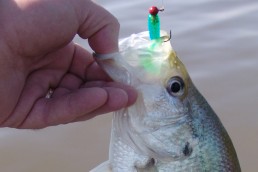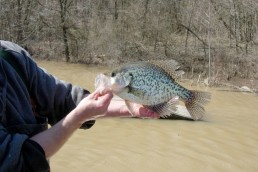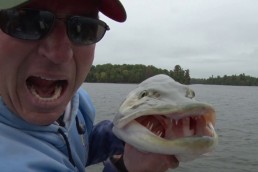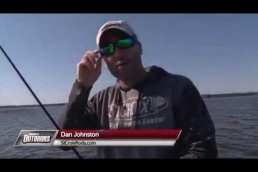Early Crappie Action on Kentucky Lake
SHARE THIS POST
It is a cold morning, but warm by Illinois standards, for this time of the year. Taking the crappie off the hook is a surprise. It is like removing an icicle with bare hands. The fish are cold, but the action—like the air—soon warms.
Beginning early in the year, crappie action begins to pick up in the famous fish factory known as Kentucky Lake. As water temperatures reach 40 degrees, the fish begin to migrate from the 20- to 25-foot range to more shallow areas of cover in the 10- to 15-foot range. As they do, they also begin to feed for short periods if not disturbed. It is the beginning of crappie season.
An incredible fishing destination
The lake is 180,000 acres of impoundment formed by the 8,700-foot dam across the Tennessee River. The dam was built in 1944 and forms a lake with a shoreline of 2,300 miles, much of which remains in its natural state.
The entire eastern shore is a recreational area. It is the part known as “Land Between the Lakes”.
Getting back to the crappie action, there are two things the angler must take into consideration: what is the water temperature and what color jig to use? As mentioned earlier, the water temperature determines the depth at which one should find fish. As the water begins to warm, the fish will move to different depths. Water temperature in the 40s produces fish in 20 to 25 feet of water and suspended.
When the water reaches 50 degrees, the fish will begin to bunch up in the 10- to 15-foot depths, with some going as shallow as 4 to 8 feet to feed.
Wood is good
Crappies in the lake like to stay close to wood. This makes areas with creek drop offs containing natural stumps a hotspot. Next in popularity are those drop-offs with brush piles. A third area is any area with stake beds near submerged brush piles. Stake beds are a popular fishing location.
Are you enjoying this post?
You can be among the first to get the latest info on where to go, what to use and how to use it!
They are nothing more than wooden stakes pounded into the lake bottom. The fish relate well to them, particularly in the spring when crappies will relate to anything wooden. Many of the stake beds are marked. Locals can tell you where others are located.
Color based on condition
As for the color of jig to use, water conditions will determine that for you. If the water color is murky to muddy, then a black/chartreuse, red/yellow, red/chartreuse or hot pink is good. Chartreuse, white/chartreuse, smoke/blue and smoke/red usually produce in slightly stained water. Clear water means to use salt/pepper, clear/glitter, orange/chartreuse or any color with flash. Jigs in the 1/8- to 1/32-ounce range are best.
Another factor to keep in mind in fishing early season crappies is that they are very easily spooked. Too much noise in a given area will scare the fish into moving or stopping feeding. To prevent this, once the fish are located, back off and make long casts. A weighted float cast beyond the area, then pulled through the area with 30-second pauses, improves chances of success. It is important to remember that crappies feed upward.
Keep lures above suspended fish. Strikes will usually occur after a pull as the jig starts to settle to the bottom of the length of line under the slip bobber. The bite will be light. Knowing when to set the hook is a matter of experience.
Warm, sandy bottoms
Water clarity and bottom structure help locate fish. If the bottom is sand and weed mix, then it will warm sooner as it holds sun warmth better. Cloudy water also warms up more quickly.
This information should help you locate early crappie on Kentucky Lake. Later, the fish will move shallower. But, that is another story. Local marinas and bait shops are the best source of information on just where they are biting today. The purchase of some jigs may just produce information on a hot area.
Regardless, if one likes to fish without a lot of competition and is tired of ice fishing this time of year, Kentucky Lake is the place to head.
MWO
SHARE THIS POST
Did you enjoy this post?
You can be among the first to get the latest info on where to go, what to use and how to use it!
Don Gasaway
Don Gasaway is a veteran freelance outdoor writer from Marion, Ill. He may also be found at: https://www.facebook.com/DonGasawayWriter and facebook.com/Wandering Angler. Comments are welcome



